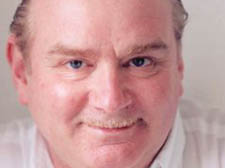|
|
 |
| |

Peter Ackroyd |
The day eight drowned in a beer explosion
Dan Carrier focuses on the St Giles area, Bloomsbury, whose grim but colourful past has long intrigued historian Peter Ackroyd
THE explosion could be heard right across the West End. Workmen were injured by pieces of red hot copper but the eight fatalities in the surrounding streets were caused not by the explosion itself, but its consequences.
When a 10,000 gallon vat of beer at the Horseshoe Brewery on the site of what is now the Dominion Theatre exploded, not only did it demolish the brewery but flooded surrounding streets: eight bodies were pulled from cellars.
The disaster, in 1818, seemed eerily fitting: for hundreds of years booze had been a staple killer in the parish of St Giles-in-the-Fields. To contemporary witnesses, there was an acceptance that the demon drink would have got its victims in the end, anyhow.
Historian Peter Ackroyd, whose book London: The Biography traces the rise of the city, is speaking on Sunday about his fascination with the St Giles area.
Despite its reputation as a crime-ridden hell-hole, St Giles boasts a church built by one of London’s leading architects: Nicholas Hawksmoor, an apprentice of Sir Christopher Wren who worked on St Paul’s with him, and built St George’s in Bloomsbury between 1716 and 1731.
Recently restored, the church boasts a statue of George I dressed in Roman regalia on top of its spire with a lion and unicorn at his feet, symbolising the end of the recent Jacobite uprising. It towered over the slums of the area, where William Hogarth created his engraving Gin Lane, with its frightening portrayal of the degeneracy of London in the 1750s.
And as Ackroyd outlines in his biography of the city, St Giles-in-the-Fields, over the years, has had an unsavoury reputation.
“The aim of the talk is to outline the life and times of the parish from the 12th century, and explain why Hawksmoor chose the site for his church,” he says.
“It was a slum area, a place for vagrants, exiles and outcasts. The Rookeries embodied the worst living conditions in all of London’s history; this was the lowest point which human beings could reach before death took hold of them, and to the Irish [who had established a community in the Covent Garden area] it seemed that the city and its inhabitants were already given over to the devil. In fact only sex and drink could make the conditions bearable.”
Hawksmoor, says Ackroyd, liked to build in parts of the city where there were clearly souls to be saved. “He had interests in Limehouse, Spitalfields, Wapping and then Bloomsbury – all deprived and desperate slums when he was building churches.”
The parish was established in the 12th century with a hospital for lepers outside the city boundaries and it attracted others banished from the city.
“The invocation of sorrow and loneliness,” writes Ackroyd, “has never entirely left. Throughout its history it has been the haunt of the poor and the outcast. Vagrants even now roam its streets and close to the church there is still a centre for the homeless.”
And Hawksmoor was fascinated, as Ackroyd points out, by the links the area had with paganism – and he included paganistic iconography in the church. “The portico was a copy of the temple of Bacchus,” explains Ackroyd.
“And St Giles was always a centre for astrology and alchemy. In the 1800s it was the headquarters for the Order of the Golden Dawn, an occult society which boasted W B Yeats among its members.”
In Elizabethan times, it was the refuge for immigrants – particularly French – who, from 1585, were expelled from the city. But it also provided land for the wealthy, who wanted an estate close to London and did not want to travel as far as the wilds of Highgate, Hampstead or beyond.
The area has long been a strange mix of the very wealthy and very poor.
A new billion pound building project guided by architect Renzo Piano is under way behind Centre Point to offer new offices, cafés, shops and housing. It is a regeneration plan aimed at raising the standard of what was a forgotten nook in the West End, a seedy corner that struggled to shake off its historically shady reputation.
It still boasts a labyrinth of a nightclub called Sin.
“If you look at the area around Denmark Street today,” says Ackroyd, “you will find the dispossessed who have been attracted to the area for 800 years.” It also had a reputation for prostitution: as Ackroyd points out, the area had been tainted by street walkers for hundreds of years.
In the 1930s novelist Patrick Hamilton, who himself fell in love with a prostitute he met in the pubs around St Giles and Bloomsbury, had one of his characters in his 1935 book 20,000 Streets Under The Sky living in a tenement block in St Giles.
Ackroyd’s book suggest that St Giles has had an inheritance passed down from the starting point that its patron saint itself looked after the underclass.
A benevolent hand that meant those in need flocked to the area. It also meant when Bloomsbury rapidly expanded in the 1700s, the church wanted to ensure there were enough pews for souls that needed saving: it meant that amid the squalor of a notorious district of London, one of Nicholas Hawksmoor’s greatest legacies to London emerged.
|

|
 |
|
 |
|

